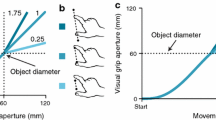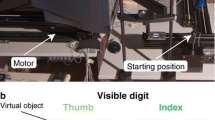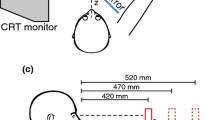Abstract
We investigated whether control of hand movements can be driven by visual information that is not consciously perceived. Subjects performed reach-to-grasp movements toward 2D virtual objects that were projected onto a rigid surface. On perturbed trials, the target object was briefly presented at a different orientation (±20° rotation) or different size (±20 % scaling) during movement. The perturbed objects were presented for 33 ms, followed by a 200-ms mask and reappearance of the original target object. Subjects perceived only the mask and were not aware of the preceding perturbed stimuli. Unperturbed trials were identical except that there was no change in the target object before the mask. Despite being unaware of the brief perturbed stimuli, subjects showed corrective adjustments to their movements: rotation of the grip axis in response to orientation perturbations, and scaling of grip aperture in response to size perturbations. Responses were detectable 250–300 ms after the perturbation onset and began to reduce 250–300 ms after the reappearance of the original target. Our results demonstrate that the visuomotor system can utilize visual information for control of grasping even when this information is not available for conscious perception. We suggest that this dissociation is due to different temporal resolution of visual processing mechanisms underlying conscious perception and control of actions.






Similar content being viewed by others
References
Bar M, Tootell RB, Schacter DL, Greve DN, Fischl B, Mendola JD, Rosen BR, Dale AM (2001) Cortical mechanisms specific to explicit visual object recognition. Neuron 29(2):529–535
Binsted G, Brownell K, Vorontsova Z, Heath M, Saucier D (2007) Visuomotor system uses target features unavailable to conscious awareness. Proc Natl Acad Sci 104(31):12669–12672
Bock O, Jüngling S (1999) Reprogramming of grip aperture in a double-step virtual grasping paradigm. Exp Brain Res 125(1):61–66
Bridgeman B, Lewis S, Heit G, Nagle M (1979) Relation between cognitive and motor-oriented systems of visual position perception. J Exp Psychol Hum Percept Perform 5(4):692
Castiello U, Bennett KMB, Stelmach GE (1993) Reach to grasp: the natural response to perturbation of object size. Exp Brain Res 94(1):163–178
Chen Z, Saunders JA (2015) Online processing of shape information for control of grasping. Exp Brain Res 233 (11):3109–3124.
Cressman EK, Franks IM, Enns JT, Chau R (2007) On-line control of pointing is modified by unseen visual shapes. Conscious Cogn 17:265–275
Cressman EK, Lam MY, Franks IM, Enns JT, Chau R (2013) Unconscious and out of control: subliminal priming is insensitive to observer expectations. Conscious Cogn 22:716–728
Desmurget M, Prablanc C (1997) Postural control of three-dimensional prehension movements. J Neurophysiol 77(1):452–464
Dubrowski A, Bock O, Carnahan H, Jüngling S (2002) The coordination of hand transport and grasp formation during single-and double-perturbed human prehension movements. Exp Brain Res 145(3):365–371
Eloka O, Franz VH (2011) Effects of object shape on the visual guidance of action. Vis Res 51(8) 925–931
Fan J, He J, Tillery SIH (2006) Control of hand orientation and arm movement during reach and grasp. Exp Brain Res 171(3):283–296
Goodale MA, Milner AD, Jakobson L, Carey D (1991) A neurological dissociation between perceiving objects and grasping them. Nature 349(6305):154–156
Goodale MA, Meenan JP, Bülthoff HH, Nicolle DA, Murphy KJ, Racicot CI (1994) Separate neural pathways for the visual analysis of object shape in perception and prehension. Curr Biol 4(7):604–610
Greenwald HS, Knill DC (2009a) A comparison of visuomotor cue integration strategies for object placement and prehension. Vis Neurosci 26(01):63–72
Greenwald HS, Knill DC (2009b) Cue integration outside central fixation: a study of grasping in depth. J Vis 9(2):11
Grill-Spector K, Kushnir T, Hendler T, Malach R (2000) The dynamics of object-selective activation correlate with recognition performance in humans. Nat Neurosci 3(8):837–843
Heath M, Maraj A, Godbolt B, Binsted G (2008) Action without awareness: reaching to an object you do not remember seeing. PLoS One 3(10):e3539. doi:10.1371/journal.pone.0003539
Hesse C, Franz VH (2009) Corrective processes in grasping after perturbations of object size. J Mot Behav 41(3):253–273
Kleinholdermann U, Franz VH, Gegenfurtner K R (2013) Human grasp point selection. J Vis 13(8). doi:10.1167/13.8.23
Kouider S, Eger E, Dolan R, Henson RN (2009) Activity in face-responsive brain regions is modulated by invisible, attended faces: evidence from masked priming. Cereb Cortex 19(1):13–23
Ludwig K, Sterzer P, Kathmann N, Franz VH, Hesselmann G (2013) Learning to detect but not to grasp suppressed visual stimuli. Neuropsychologia 51(13):2930–2938
Milner AD (2012) Is visual processing in the dorsal stream accessible to consciousness? Proc R Soc B Biol Sci 279(1737):2289–2298. doi:10.1098/rspb.2011.2663
Milner AD, Goodale MA (1995) The visual brain in action, vol 27. Oxford University Press, Oxford
Milner AD, Goodale MA (2008) Two visual systems re-viewed. Neuropsychologia 46(3):774–785
Noguchi Y, Kakigi R (2005) Neural mechanisms of visual backward masking revealed by high temporal resolution imaging of human brain. Neuroimage 27(1):178–187
Paulignan Y, MacKenzie C, Marteniuk R, Jeannerod M (1991) Selective perturbation of visual input during prehension movements: II. The effects of changing object size. Exp Brain Res 83(3):502–512
Pélisson D, Prablanc C, Goodale MA, Jeannerod M (1986) Visual control of reaching movements without vision of the limb. Exp Brain Res 62(2):303–311. doi:10.1007/bf00238849
Prablanc C, Martin O (1992) Automatic control during hand reaching at undetected two-dimensional target displacements. J Neurophysiol 67(2):455–469
Roseboom W, Arnold DH (2011) Learning to reach for ‘invisible’ visual input. Curr Biol 21(13):R493–R494
van Mierlo CM, Louw S, Smeets JB, Brenner E (2009) Slant cues are processed with different latencies for the online control of movement. J Vis 9(3):25
Voudouris D, Smeets JBJ, Brenner E (2013) Ultra-fast selection of grasping points. J Neurophysiol 110(7):1484–1489
Westwood DA, Danckert J, Servos P, Goodale MA (2002) Grasping two-dimensional images and three-dimensional objects in visual-form agnosia. Exp Brain Res 144(2):262–267
Yuval-Greenberg S, Heeger DJ (2013) Continuous flash suppression modulates cortical activity in early visual cortex. J Neurosci 33(23):9635–9643
Acknowledgements
This work was supported by a grant from the Hong Kong Research Grants Council, GRF HKU-753211H.
Author information
Authors and Affiliations
Corresponding author
Rights and permissions
About this article
Cite this article
Chen, Z., Saunders, J.A. Automatic adjustments toward unseen visual targets during grasping movements. Exp Brain Res 234, 2091–2103 (2016). https://doi.org/10.1007/s00221-016-4613-9
Received:
Accepted:
Published:
Issue Date:
DOI: https://doi.org/10.1007/s00221-016-4613-9




